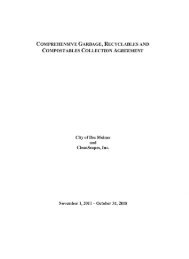CITY OF DES MOINES SHORELINE MASTER PROGRAM
CITY OF DES MOINES SHORELINE MASTER PROGRAM
CITY OF DES MOINES SHORELINE MASTER PROGRAM
You also want an ePaper? Increase the reach of your titles
YUMPU automatically turns print PDFs into web optimized ePapers that Google loves.
Des Moines Shoreline Inventory and Characterization<br />
Salmonids<br />
The Habitat Limiting Factors and Reconnaissance Assessment Report, Green/Duwamish and<br />
Central Puget Sound Watersheds (WRIA 9 and Vashon Island) (Kerwin and Nelson, 2000), A<br />
Catalog of Washington Streams and Salmon Utilization - Volume I, Puget Sound Region<br />
(Williams et al., 1975), and Water Type Survey Results South King County May/June, 2003<br />
(Washington Trout, 2004) identify the known presence of salmon in local streams. Des Moines<br />
Creek (Segment A) has documented salmonid use including Chinook salmon (listed as<br />
threatened under the ESA), chum salmon, coho salmon (Federal candidate species), coastal<br />
cutthroat trout, pink salmon, and steelhead (Figure 14). Segment B contains no streams. Massey<br />
Creek (Segment C) contains Chinook salmon, coho salmon, and coastal cutthroats. The unnamed<br />
creek in Segment C is not known to support any salmonid populations due to the elevation of the<br />
discharge point into Puget Sound. McSorley Creek (Segment D) has documented use by chum<br />
salmon, coho salmon, and coastal cutthroats. One possible juvenile sockeye was also<br />
documented in the creek (Washington Trout, 2004). Woodmont Creek (Segment E) has<br />
documented cutthroat trout. Redondo Creek (Segment F) has the habitat to support coho salmon<br />
and cutthroat trout although none have been observed (Kerwin and Nelson, 2000). Cold Creek<br />
(Segment G) has cutthroat trout and is reported by local residents as containing coho and chum<br />
salmon (Kerwin and Nelson, 2000). WDFW PHS and Streamnet data (2004) indicate that the<br />
only use of streams in the City’s shoreline jurisdiction occurs in Des Moines Creek (Segment A)<br />
and McSorley Creek (Segment D) including, coho and cutthroat trout use of Des Moines Creek<br />
and coho use of McSorley Creek.<br />
Nearshore habitat is an important environment for juvenile salmonids, where the shallow water<br />
depth obstructs the presence of larger, predator species (Kerwin and Nelson, 2000). All shoreline<br />
segments within the City’s shoreline jurisdiction are known or expected to contain juvenile<br />
salmonids including bull trout (federally listed), Chinook, chum, coho, cutthroat, pink, and<br />
sockeye based on the knowledge of species life histories (KCDNR, 2001).<br />
Forage Fish<br />
Forage fish include species that as adults breed prolifically and are small enough to be prey for<br />
larger species. They are often non-game fish. Four primary sources were referenced in compiling<br />
information on potential forage fish spawning areas within the City’s shoreline jurisdiction:<br />
Marine Resource Species (MRS) data maintained by WDFW (2004), the Habitat Limiting<br />
Factors and Reconnaissance Assessment Report, Green/Duwamish and Central Puget Sound<br />
Watersheds (WRIA 9 and Vashon Island) (Kerwin and Nelson, 2000), and the Reconnaissance<br />
Assessment of the State of the Nearshore Environment (KCDNR, 2001).<br />
The five forage fish species most likely to occur in the City’s shoreline jurisdiction include surf<br />
smelt, sand lance, Pacific herring, longfin smelt, and eulachon (Kerwin and Nelson 2000 and<br />
King County DNR, 2001) (Figure 14). Different species utilize different parts of the intertidal<br />
and subtidal zones, with sand lance and surf smelt spawning primarily in the substrate of the<br />
upper intertidal zone, and Pacific herring spawning primarily on intertidal or subtidal vegetation<br />
(Lemberg et al., 1997). Information on the five potential forage fish species within the City’s<br />
jurisdiction is summarized in Table 8.<br />
Page 36 March 2005



